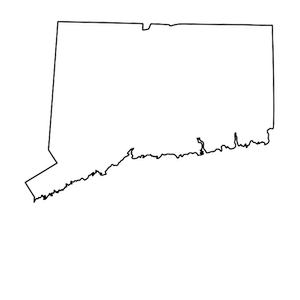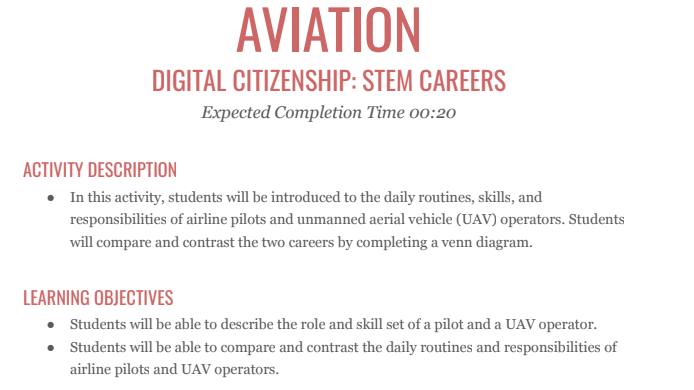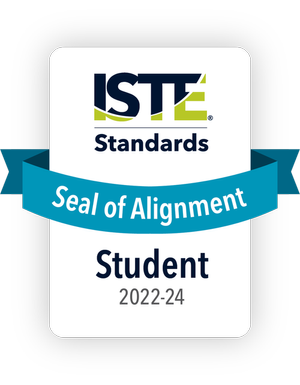Connecticut K-12 Computer Science Standards
Download a free 3-5 STEM career lesson that aligns with the Connecticut computer science standards.

Ellipsis Education is an approved for use computer science resource for the state of Connecticut.
Ellipsis Education is Compliant – CT pledged. Compliancy pledged products have agreed to the CTEdTech Student Data Privacy Pledge.
Ellipsis Education Computer Science Curriculum
Ellipsis Education computer science curriculum is grade-level differentiated, aligns with Connecticut state standards, and is continually updated to reflect changes in computer science. Since computer science is more than just coding, Ellipsis Education courses include coding, unplugged, digital citizenship, and STEM career lessons as well as hardware integrations.
Free Computer Science Lesson

COMPUTER SCIENCE LESSON PLAN
In the lesson Aviation, students will be introduced to the daily routines, skills, and responsibilities of airline pilots and unmanned aerial vehicle (UAV) operators. Students will compare and contrast the two careers by completing a venn diagram. This STEM career lesson is built for grades 3-5 and aligns with the Connecticut computer standards for elementary students. The lesson includes links to the appropriate materials and resources, a detailed procedure, activity tips, and a bonus challenge activity.
Connecticut Computer Science Standards
The Connecticut State Department of Education (CSDE) adopted computer science standards from two nationally recognized sets of K-12 CS standards: ISTE standards and CSTA standards. Connecticut’s vision for computer science is that these two sets of standards can work together to best prepare today’s students. The ISTE standards for students were adopted in order for students to learn how to use technology. Educators should integrate the ISTE standards into the academic day across all subject areas. The CSTA standards for students were adopted in order for students to learn how to create technology. Educators should teach the CSTA standards in the academic subject area of computer science. In the next two sections, learn more about each set of standards.
ISTE STANDARDS
The ISTE computer science standards are designed to promote learning, teaching, and leading in K-12 classrooms across the globe. There are ISTE standards educators and ISTE standards for administrators, but the ISTE standards for students are used in the Connecticut computer science standards.
There are 7 areas of the ISTE student standards that recur in grades K-12. You can find the ISTE standards pdf here.
-
Empowered Learner – Students leverage technology to take an active role in choosing, achieving and demonstrating competency in their learning goals, informed by the learning sciences.
-
Digital Citizen – Students recognize the rights, responsibilities and opportunities of living, learning and working in an interconnected digital world, and they act and model in ways that are safe, legal and ethical.
-
Knowledge Constructor – Students critically curate a variety of resources using digital tools to construct knowledge, produce creative artifacts and make meaningful learning experiences for themselves and others.
-
Innovative Designer – Students use a variety of technologies within a design process to identify and solve problems by creating new, useful or imaginative solutions.
-
Computational Thinker – Students develop and employ strategies for understanding and solving problems in ways that leverage the power of technological methods to develop and test solutions.
-
Creative Communicator – Students communicate clearly and express themselves creatively for a variety of purposes using the platforms, tools, styles, formats and digital media appropriate to their goals.
-
Global Collaborator – Students use digital tools to broaden their perspectives and enrich their learning by collaborating with others and working effectively in teams locally and globally.
CSTA STANDARDS
The CSTA computer science standards are a nationally recognized set of computer science standards developed by the Computer Science Teachers Association. They aim to provide an age appropriate, rigorous, and accessible foundation for schools and districts looking to implement computer science in K-12.
The CSTA standards for students are organized by grade band (K-2, 3-5, 6-8, 9-12). Explore the standards and download the CSTA standards progression chart on the CSTA standards web page. Here is an overview of the concepts and subconcepts included:
-
Computing Systems
-
Devices
-
Hardware & Software
-
Troubleshooting
-
-
Networks and the Internet
-
Network Communication & Organization
-
Cybersecurity
-
-
Data Analysis
-
Storage
-
Collection, Visualization, & Transformation
-
Inference & Models
-
-
Algorithms & Programming
-
Algorithms
-
Variables
-
Control
-
Modularity
-
Program Development
-
-
Impacts and Computing
-
Culture
-
Social Interactions
-
Safety, Law, & Ethic
-
To help you teach the computer science standards CSTA, download this free lesson. Built for grades K-2, it teaches the concepts of loops and algorithms. If you teach grades 6-8, download this free lesson in which students create their own webpage. All of our free lessons and courses align with the Connecticut state standards for computer science
Integrating Computer Science Standards
The Connecticut computer science standards can be integrated into other academic areas, including the common core standards. For example, The common core standards math can be taught when teaching the concept of algorithms in computer science. To teach algorithms in your classroom, try this free lesson for grades K-2 or this free lesson for high school.
Likewise, the common core standards ELA can tie to computer science. For example, when assigning a research project during ELA class, you may want to teach about internet safety before allowing students to explore their research topics on the web. Check out this free lesson about leaving a good digital footprint to incorporate computer science into your classroom.
In addition, there are lots of ways to integrate computer science into the Connecticut state standards for science. In our blog Interdisciplinary Connections: Science, we explain how to incorporate computer science instruction into other science domains, such as physical science, life science, and earth & space science. To get you started, check out our My STEM Career podcast. In these interviews, we talk with professionals in STEM, and they describe how they use computer science in their daily jobs. Some notable interviews in relation to other branches of science include our episodes with a doctor and an engineering manager. You can also try out this free STEM career lesson in which students explore roles as a computational linguist. Finally, to teach other branches of the CT in education science standards while students interact with coding, visit this Code.org page that includes lessons that integrate the areas of science.
Computer Science Education Requirements
Now that you have explored the Connecticut state computer science standards and understand the basics of computer science education, how can you get started? Perhaps you are new to teaching computer science and don’t know how to begin to focus your efforts. Perhaps you do have some experience and knowledge of the basics, but struggle with a curriculum progression that makes sense for your students. The pressure is on to deliver computer science knowledge to students that may know more than you! Luckily, there are a few baseline requirements that can help you create a computer science implementation plan.
The first part of your computer science implementation plan is your teachers. Finding passionate educators that will engage and learn alongside students is essential. Good news: your teachers do not have to have experience with computer science. Programming languages that come and go; there will always be something new on the horizon. One of the benefits of studying computer science is that having a strong foundation in certain concepts will be relevant for all languages and most applications going forward. Success in computer science is much more than just coding. It’s being a problem-solver, thinking critically, and having the ability to collaborate effectively with peers. Seeking growth in those essential skills is just as applicable for teachers as it is for students. There are many organizations that offer free educational events and communities for teachers interested in computer science. Furthermore, Ellipsis Education offers free professional development webinars that dive into different computer science subject areas.
Next, choose a curriculum that aligns with your school’s unique instructional strategy for computer science. There are multiple things to consider here.
-
Standards alignment: You want to align with the Connecticut K-12 computer science standards, which includes determining which lessons cover the standards, when they will be taught, and generating the alignment documentation.
-
Pacing: You want to establish fidelity of instruction across class periods, classrooms, and grade levels. You want a consistent curriculum for your teachers and students that is tailored to your scheduling needs.
-
Assessment methods: Students learn and demonstrate knowledge differently, so you want multiple ways to gain insight into your classroom, including summative and formative assessments.
-
Lesson plans: You want to make sure that lessons within the curriculum are scaffolded and paced to deliver student outcomes, and empower teachers to create an engaging student experience.
Finally, reflect on the values of teaching computer science. Our students are the most important consideration in any new program. You want to engage them, surprise them, and teach them the skills they need for their future. It is powerful to give students the opportunity to see a project come to life before their eyes. Enjoy watching your future computer science experts discover their potential!
Underneath “Related Articles” on this page, you can find other teaching computer science articles to help you on your journey.
K 12 Computer Science Curriculum
Ellipsis Education provides full-year K-12 computer science curriculum that aligns with the Connecticut K-12 computer science standards. In addition, all Ellipsis Education courses have been awarded the ISTE Seal of Alignment. This seal means Ellipsis Education aligns with the ISTE standards and provides a high-quality, standards-aligned learning experience that enhances students’ digital age skills.The curriculum offers grade level differentiated learning pathways, aligns with all state and national computer science standards, and is continually updated to reflect changes in computer science. Ellipsis Education courses are customized to districts’ unique instructional strategy for computer science integration. This can mean incorporating computer science into an existing class period, adding to a specials rotation, or introducing a stand alone class. Courses are delivered with instructional resources teachers need to feel confident teaching computer science in K-12.
Our computer science curriculum for K-2 empowers you to engage your students with courses that fuel their interest. Coding lessons use ScratchJr, an introductory block coding language, perfect for emergent and early readers. In grades 3-5, inspire your students with courses that spark their creativity. Coding lessons use Scratch, a block based coding language, ideal for the transitional and fluent reader.
Our computer science curriculum middle school (6-8) helps you motivate your students with courses that connect to their world. Coding lessons use line based languages JavaScript, HTML, CSS, and Java to explore programming options.
Our computer science high school curriculum (9-12) helps you empower your students with courses that expand their skills. Coding lessons use JavaScript, Java, Python, and Godot to develop websites, programs, and games.
Explore our full k-12 computer science education course offering on our courses page. If any of these course options interest you, schedule a 30 minute call with one of our curriculum experts. Find the curriculum that will support every teacher as they inspire every student.
Computer Science Degree
After being introduced to computer science curriculum in K-12, students may be inspired to continue their computer science education. On a professional level, companies are recruiting for computer science degree jobs in cloud computing, app development, and statistical analysis. On an individual level, computational thinking, problem solving, and relationship building are all deeply influenced by computer science. This understanding of computer science jobs leads to much broader applications. you don’t necessarily need a degree in computer science; anyone that uses technology to solve problems can be considered a computer scientist!
Introducing computer science in the K-12 experience opens doors for students to pursue a computer science degree in college. The top computer science colleges in Connecticut, including Yale, Wesleyan University, and University of Connecticut, offer concentrations in various areas of computer science, like computer information systems, information technology, computer software and applications, and computer systems networking. The reality is, though, students do not need to attend a top university to pursue these computer science majors. Even non-STEM majors, like business, biology, and English use computer science skills to communicate ideas.
Likewise, computer science skills taught in K-12 can be applied directly to any career students pursue after high school. Computational thinking, problem solving, and teamwork can be applied in trades (like electrician, plumber, and HVAC) and other positions (like retail, restaurants, and reception).
Ellipsis Education spotlights the many forms of computer science careers in our My STEM Career podcast. In these interviews, hear from professionals, students, and teachers as they share how they built confidence in their computer science skills. Two particularly interesting interviews include Will Muto, a Product Technical Director at Industrial Light and Magic, who worked on Star Wars films, and Alia Enos, Software Developer II at 343 Industries, who works on the Halo video game series. In addition, Ellipsis Education offers free STEM career lessons, including this one that aligns with Connecticut high school science standards.
Download a Free Lesson

COMPUTER SCIENCE LESSON PLANS
In the STEM career lesson Aviation, students will be introduced to the daily routines, skills, and responsibilities of airline pilots and unmanned aerial vehicle (UAV) operators. Students will compare and contrast the two careers by completing a venn diagram. This lesson aligns with the Connecticut standards computer science and the ISTE standards for students pdf. The grades 3-5 lesson includes links to the appropriate materials and resources, a detailed procedure, activity tips, and a bonus challenge activity.

